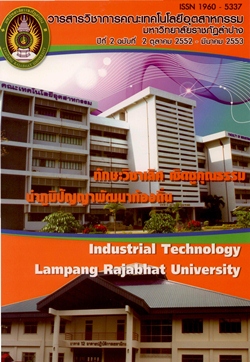สมบัติการรับแรงของดินซีเมนต์ผสมเถ้าลอยสำหรับงานปรับปรุงสมบัติโดยวิธีผสมลึกในชั้นดินเชียงใหม่
Keywords:
การปรับปรุงคุณสมบัติดิน, เสาเข็มดินซีเมนต์, กำลังรับแรงอัดแกนเดียว, กำลังรับแรงอัดสามแกน, Soil Stabilization, Cement Column, Unconfined Compressive Strength, Triaxial Compressive StrengthAbstract
-
Strength Properties of Soil - Cement - Fly Ash for Deep Mixing Stabilization in Chiang Mai Subsoil
Series of laboratory test were conducted to investigate strength properties of cement - fly ash stabilized soil. The objective of the study is to investigate the possibility of partial replacement of cement with fly ash in the process of making soil cement column by deep mixing techniques. Subsoil boring was conducted to collect 3 soil sample representing Chiang Mai subsoil profile : top soil, clayey sand (SC) and stiff clay. Two test series were conducted to study strength properties of stabilized soils. In the first test series, unconfined compression test on soil stabilized with various ratios of stabilizing agent were conducted to establish suitable ratio. In the second test series, triaxial compression were conducted to study stress - strain properties of the stabilized soil. In the unconfined compression test series, the stiff clay soil sample was mixed with cement and fly ash at binding volume of 200 kg/m3 and 400 kg/m3 and with 5 different ratio of cement to fly ash (C:F) ranging between 10:90 to 50:50. The results show that mixtures which could produced stabilized soil having unconfined compressive strength of 60 t/m2 suitable for soil cement column in deep mixing could have ratio of cement : fly ash 50:50 or 40:60 or 31:69 with binder volume of 280 kg/m3, 385 kg/m3 and 400 kg/m3 respcetively
In the triaxial compression test series, all the 3 soil sample were mixed with cement and fly ash at binding volume of 200 kg/m3 and 300 kg/m3 and with ratio of cement fly ahs to 17:83 and 10:90 respcetively. At to 28 days of curing, the samples were subjected to unconsolidated undrained triaxial test at 15, 20 and 25 t/m2 confining pressure. Results of the test indicate that, eventhough confining pressure has very little effect on the compressive strength, effects on modulus of elasticity (E50) are clear. In the relationship between modulus of elasticity and shear strength E50= K.Su the coefficient K can be related to the confining pressure by the equation K = 0.303 + 91.55 (
3 = t/m2 )






